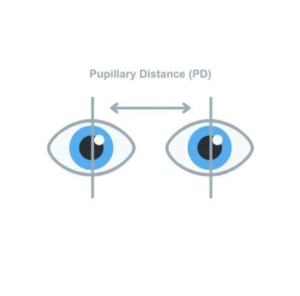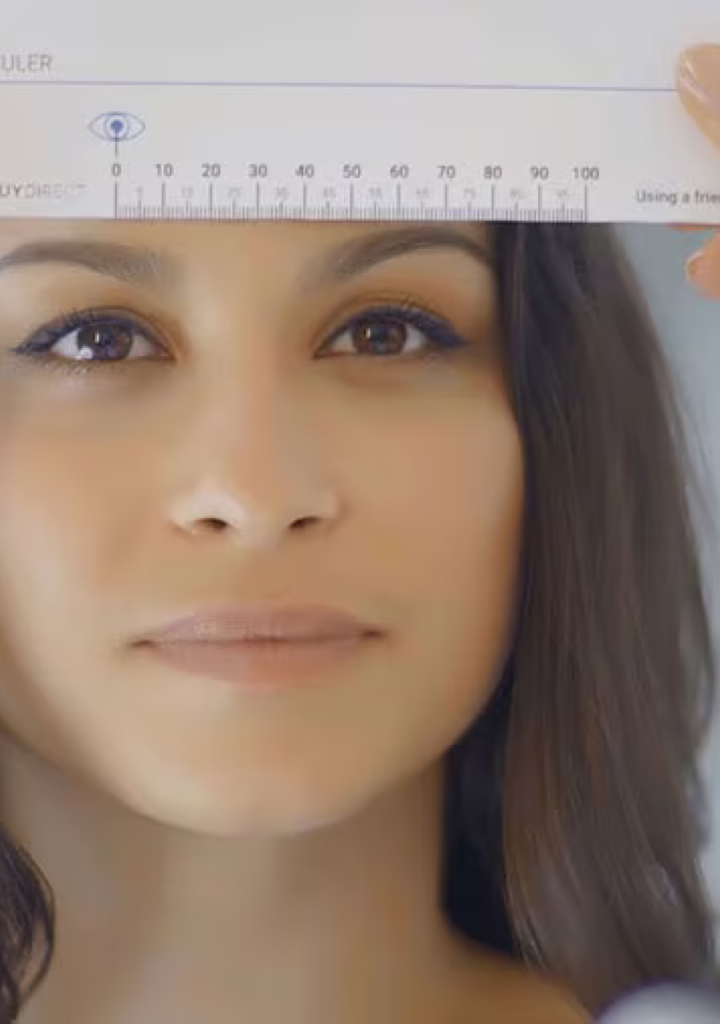How to Measure PD
Ever picked out the coolest glasses just to end up with a headache from wearing them? It all boils down to a tiny yet mighty detail – your pupillary distance (PD).
This measurement determines how comfortable your glasses feel. It’s like the secret ingredient to a perfect vision recipe, and getting it wrong can turn your dream glasses into a real pain. And let’s face it, measuring your PD sounds like a task you’d gladly pass on. But guess what? It’s not rocket science — and you don’t need to be a pro to get it right.
In this article, we’ll unravel the mystery of how to measure pupillary distance with little effort. Say goodbye to guesswork and hello to glasses that not only look good but feel great too!

What Is Pupillary Distance?
Pupillary distance (PD) is a measurement representing the distance between the centers of your pupils — essential for the correct positioning of lenses in your eyeglasses. Proper PD ensures that you are looking through the optimal part of the lens, which is vital for clear and accurate vision.
The accuracy of PD extends beyond visual clarity. It also impacts the comfort of your eyewear. Correctly aligned lenses mean your eyes can maintain their natural position, preventing strain and making your glasses feel comfortable, even after prolonged use.
In essence, a precise PD measurement is fundamental to both the functionality of your glasses and your visual health. Having eyeglasses that are customized to your PD is key to enjoying a comfortable fit alongside optimal vision quality.
Measuring Pupillary Distance: Tools And Preparation
Before you start measuring your PD, it’s important to have the right tools and proper setup to ensure you get the best results. In this section, we prepared a list of things you need to consider.
Choose The Right Tools
- Ruler or PD ruler. Most rulers will do the job, but a PD ruler, often available for free from many optometrists or eyewear stores, is designed specifically for this task.
- Mirror. A medium to large mirror that allows you to see your entire face.
- Good lighting. Make sure the area in front of the mirror is well-lit to see your pupils.
Setting Up The Environment
- Clean space. Start by clearing the area in front of your mirror. You need a clean, uncluttered space to stand or sit comfortably while you measure.
- Correct posture. Whether standing or sitting, maintain a straight posture. Your head should be level, and your eyes should look straight ahead.
- Eye level. Adjust the mirror (if possible) or your position so that the mirror is at eye level. This helps to get an accurate measurement by ensuring you’re looking straight ahead.
- Ruler preparation. If you’re using a standard ruler, familiarize yourself with the centimeter side, as PD is usually measured in millimeters. For a PD ruler, it’s important to understand the markings before you start the process.

Measuring PD On Your Own
Contrary to popular belief, measuring PD on your own is a straightforward process. Here are the things you need to consider:
- Stand or sit straight. Position yourself about 20 cm (8 inches) away from the mirror, directly facing it with your head straight and eyes level.
- Hold the ruler. Place the ruler horizontally across the bridge of your nose, aligning the 0 mm mark with the center of your right pupil. Make sure the ruler is stable and parallel to the floor.
- Measure. Looking straight into the mirror, identify the millimeter mark that aligns with the center of your left pupil. This requires a steady hand and a focused eye to avoid parallax errors.
- Repeat for consistency. For the best accuracy, repeat the measurement a few times. Consistent readings indicate you’ve measured your PD correctly.
Remember, a precise PD measurement is key to glasses that fit well and provide clear vision, so take your time with each step.

Measuring PD With Assistance
- Measuring your PD with the help of another person is not only easier but also tends to be more accurate. This method may be particularly useful for those who find self-measurement challenging.
- To start, you and your helper should stand or sit facing each other, about an arm’s length apart. Both of you should be at the same height and eye level. It’s important for you to focus on a point directly behind your helper to keep your gaze steady and your eyes parallel.
- The next step involves your helper placing the ruler across the bridge of your nose, carefully aligning its 0 mm mark with the center of one of your pupils.
- While you maintain your focus on the distant point, your helper will then read the measurement that aligns with the center of your other pupil directly from the ruler.
Having someone assist with the measurement not only allows you to relax more during the process but also benefits from the assistant’s steady hand and eye, leading to potentially more precise readings.
Given the convenience of this approach, it is highly recommended for first-timers or those who prefer not to measure themselves.
Additional Things To Consider When Measuring PD
Aside from the right tools and preparation, there are a few more things to be aware of when measuring your PD. Considering these factors will help you get the best results based on your particular situation.
Single PD vs. Dual PD
Single PD refers to the total distance in millimeters between the centers of your pupils, measured as one complete number. It’s used when your focus is centered, such as for reading or looking at a computer screen, and is often applied for glasses with single-vision lenses.
Dual PD, on the other hand, splits this measurement into two numbers, representing the distance from the center of each pupil to the bridge of your nose. This measurement accounts for the fact that many people’s eyes are not symmetrically spaced and offers a more tailored fit for your eyewear, especially important for bifocal or progressive lenses.
The key difference between single and dual PD is precision. While single PD provides a general measurement useful for standard applications, dual PD offers a more personalized approach, where each eye is accurately aligned with its respective lens for optimal clarity and comfort.

Mistakes To Avoid When Measuring PD
Accuracy plays a key part when measuring your PD, and certain missteps can lead to less-than-ideal results.
One common mistake is relying on a single measurement. It’s vital to take multiple measurements to ensure consistency and accuracy. Small deviations can significantly affect your vision and comfort, so repeat the process a few times and use the average for the most reliable PD.
Also, while DIY methods appear convenient, they’re not foolproof. If you’re ever unsure about your home measurements, it’s wise to consult a professional optician who has the tools and expertise to accurately measure your PD.
When looking for perfect eyewear, a professional’s input can make all the difference in making sure your glasses fit perfectly and enhance your vision.
Choose Your Eyewear
Once you’ve successfully measured your PD, it’s time to look for your desired eyeglasses.
With so many available options in the market, the search process can be a slightly overwhelming task.
For this reason, we’re offering our stylish selection of eyewear for everybody’s needs, including men, women, kids, or unisex options.
Don’t hesitate to check out our catalog.
FAQ
Can I guess my PD?
No. Guessing your PD is not advisable. Incorrect PD measurements can lead to eyestrain, headaches, and blurred vision. For the best results, accurate measurement using proper tools or consultation with an eye care professional is essential to ensure your eyewear provides optimal vision and comfort.
Can pupillary distance change over time?
PD is generally stable in adults but can change due to certain factors such as eye surgery, significant weight fluctuations, or aging. Regular eye exams are important to detect any changes and ensure eyeglass prescriptions remain accurate for optimal vision and comfort.
How to measure pupillary distance at home?
To measure pupillary distance (PD) at home, stand in front of a mirror with a ruler. Align the ruler’s 0 mm mark with the center of one pupil, then measure the distance to the center of the other pupil. Repeat for accuracy and use the average measurement.
What’s the average pupillary distance?
The average pupillary distance (PD) for adults ranges from 54 to 68 mm, with most falling around 63 mm. Children have a smaller PD, typically between 43 to 54 mm. However, individual measurements can vary significantly. It’s important to obtain a precise measurement for eyewear.







